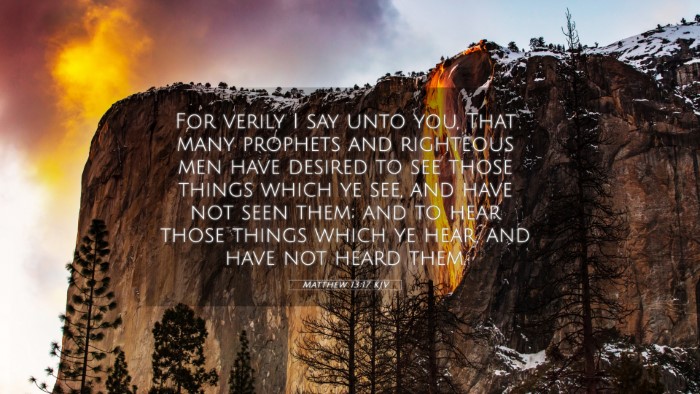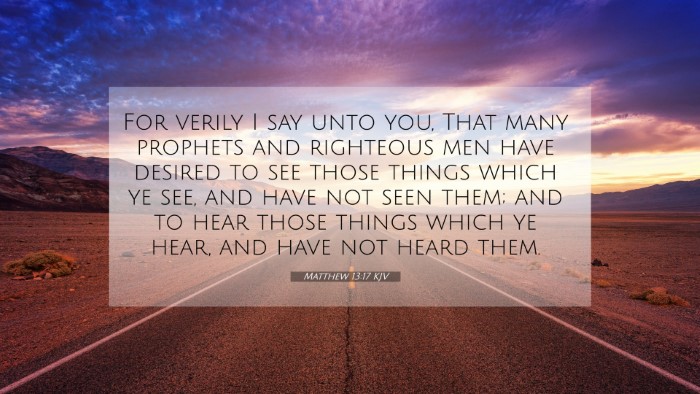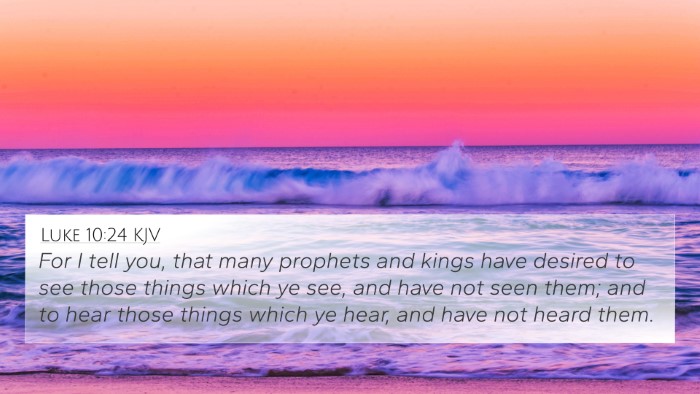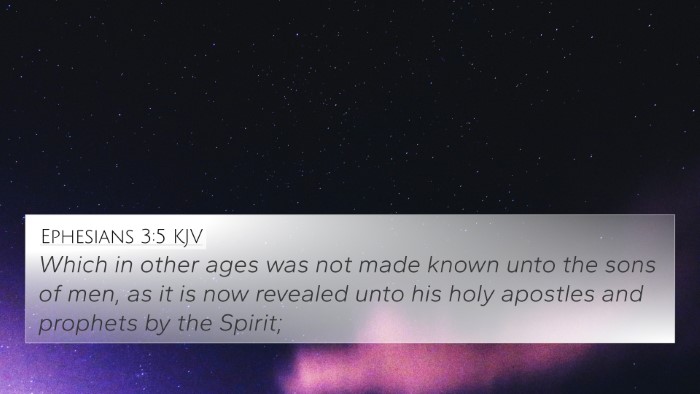Understanding Matthew 13:17
Matthew 13:17 states: "For verily I say unto you, That many prophets and righteous men have desired to see those things which ye see, and have not seen them; and to hear those things which ye hear, and have not heard them."
Summary and Interpretation
This verse highlights the privilege of Jesus' disciples to witness His ministry and teachings. As noted by Matthew Henry, this verse emphasizes the unique position of the disciples during Jesus' time. Many esteemed figures of the Old Testament longed for the revelation and experiences that were granted to the followers of Jesus. Their desire illustrates a longing for the Messiah, a central theme throughout the prophetic literature.
Albert Barnes further elaborates that the inability of the prophets and righteous men to see these things signifies the fulfilled prophecies in Christ. The disciples were witnessing events that generations before them had longed to see, which elevates their calling and faith. This serves to establish the significance of Jesus' mission in fulfilling the law and the prophets.
Adam Clarke noted that this longing reflects the nature of divine revelation. The statement serves as an affirmation of God's plan across history, showing that the messianic age is a revelation previously anticipated. The prophets, while righteous and faithful, lived prior to the full realization of God's promises in Christ.
Cross-References to Matthew 13:17
- Luke 10:24 - "For I tell you that many prophets and kings desired to see what you see, and did not see it, and to hear what you hear, and did not hear it."
- 1 Peter 1:10-12 - "Of which salvation the prophets have inquired and searched diligently, who prophesied of the grace that should come unto you."
- John 8:56 - "Your father Abraham rejoiced to see my day: and he saw it, and was glad."
- Hebrews 11:13 - "These all died in faith, not having received the promises, but having seen them afar off, and were persuaded of them, and embraced them."
- Matthew 5:17 - "Think not that I am come to destroy the law, or the prophets: I am not come to destroy, but to fulfill."
- Acts 13:27 - "For they that dwell at Jerusalem, and their rulers, because they knew him not, nor yet the voices of the prophets which are read every sabbath day, they have fulfilled them in condemning him."
- Matthew 11:13 - "For all the prophets and the law prophesied until John."
Thematic Connections and Insights
The verse invites deeper engagement with the narrative of redemption as revealed throughout Scripture. The dynamic between various biblical figures illuminates how expectations evolved through covenants. Building upon the commentary insights, it becomes clear that understanding the connections in Bible verses fosters a comprehensive grasp of God's unfolding plan.
Tools for Bible Cross-Referencing can further enhance the exploration of themes related to Matthew 13:17. Using a bible concordance, one can easily locate related passages to see how the longing for prophetic fulfillment is woven throughout the Old and New Testaments.
Engaging in cross-reference Bible study methods allows for identifying deeper meanings and connections between verses that may not be immediately apparent. This enhances not only individual study but also preparation for teaching and preaching.
Applying the Insights
Understanding Matthew 13:17 through cross-referencing biblical texts not only enriches one's faith journey but also equips believers with resources like a bible cross-reference guide that fosters comprehensive bible study. Appreciating parallels found across scripture illuminates the continuity of God's revelation.
For those seeking to find cross-references for specific Bible verses, utilizing a bible reference resource can streamline connecting thematic elements. This also encourages community dialogue as believers share insights on inter-Biblical discussions between the prophetic writings and the Gospels.
Final Reflection
Matthew 13:17 serves as a profound reminder of the blessings and responsibilities bestowed upon those who follow Christ. It illustrates the bridge between the old covenant experience and the new covenant reality, where the longings of past generations are met in Christ. Thus, the connections between Bible verses not only serve as historical reference points but also point us to the living reality of faith today.
As one delves into the rich tapestry of scripture, engaging in comparative Bible verse analysis fosters a deeper understanding of the overarching narrative of redemption. Embracing the inter-Biblical dialogue created through such connections allows contemporary believers to experience a fuller understanding of holiness, grace, and the profound love of God.








